Features
Guitarist

A 1958 Fender Jazzmaster in rare Sparkle Surfburst
(Image credit: Future / Phil Barker)
Nobody disputes the fact that the Jazzmaster was designed for jazz guitarists, so it’s hard to understand why Leo Fender imagined all those ‘one tone for everything’ archtop huggers would be drawn to complex control layouts and a floating vibrato mounted on a plank. And if anything, the Jaguar is an even more baffling proposition.
Like so many of Leo Fender’s products, these instruments ended up being wildly successful at producing sounds that ran contrary to his intentions and that would not have met his approval.
That’s why we’re going to take a deep dive into the radical design features, ingenious hardware and innovative electronics that make Fender’s finest offset guitars more popular than ever and continue to inspire guitar players and builders alike.
Offset Bodies
The Jazzmaster and Jaguar body shape represents a significant departure from conventional guitar design. Guitar bodies had traditionally been symmetrical – cutaways notwithstanding – but the offset waist was introduced for ergonomic reasons and the term ‘offset’ is now generally applied to most asymmetrical guitars.
Observing how jazz players performed, Leo Fender and Freddie Tavares set out to design a guitar that would feel more comfortable in a seated position.
As Leo explained to author Tom Wheeler in American Guitars: An Illustrated History: “Normally, the player is forced to hold the guitar at an angle to play it because it’s not balanced. So it was a matter of fitting it to the ribcage. The offset waist […] went right along with the idea of the dressed away portion in the back. It was just a matter of function.”
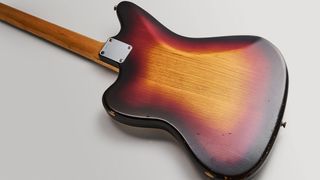
(Image credit: Future / Phil Barker)
The body was larger and generally heavier than Tele and Strat types and was slightly thinned down by mid-1959. Most were constructed from two or three pieces of alder, but rare blonde-finished examples were ash.
All the latest guitar news, interviews, lessons, reviews, deals and more, direct to your inbox!
When surf groups started playing them, the Mosrite company took notice and introduced offset models of its own that were good enough to lure The Ventures away from Fender
Most Jazzmasters are played standing up, which somewhat undermines the design concept and makes the neck feel like it’s protruding further from the body. The Jaguar body, meanwhile, was pretty much identical, besides a slightly pointier top horn.
When surf groups started playing them, the Mosrite company took notice and introduced offset models of its own that were good enough to lure The Ventures away from Fender.
Gibson’s reverse Firebird came out in 1963 with a body and headstock that looked like an upside-down offset. Some say Fender took exception, prompting Gibson to introduce the non-reverse Firebird in 1965.
In truth, it was probably done to relaunch an under-performing model and reduce production costs. But if Gibson was really responding to Fender, why is the non-reverse design even more Fender-like? You might conclude Gibson was ‘flipping the ’bird’.
Necks
The desire to move upmarket resulted in the Jazzmaster being the first Fender with a rosewood fretboard and top-loaded truss rod. An early advert shows a Jazzmaster with Telecaster knobs, black pickup covers and a rosewood-capped neck with a walnut plug at the headstock, but it was probably a prototype.
The headstock shape is subtly different from the Strat’s, with a tad more curve on the bottom. The Jaguar neck’s 24-inch scale length was shorter than the Jazzmaster’s 25 ½-inch scale, and it had 22 frets, rather than 21. This gives Jaguars a slightly looser and slinkier feel, for the equivalent string gauge, and arguably a warmer acoustic response.
Up to mid-1962 all Jazzmasters and the very earliest Jaguars had slab-rosewood fingerboards. Fender changed to veneer ’boards from July 1962 onwards and began binding them in 1965. The Jaguar’s headstock was always slightly bigger and more curved – a portent of the ‘big headstocks’ that would follow.
Hardware
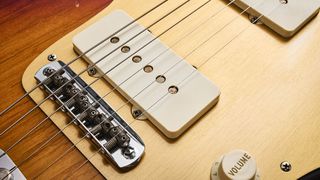
(Image credit: Future / Phil Barker)
Had Leo Fender been left to his own devices, the Stratocaster would have been equipped with a vibrato very similar to the design featured on the offsets. He’d understood that low friction was key to stable tuning and designed a bridge with roller saddles.
After Bill Carson’s road tests revealed a vibration issue with the bearings and poor sustain, Freddie Tavares talked Leo into a complete redesign. It must have stung because $5,000 had already been invested in tooling, but Leo eventually revisited his favoured option.
The bridge was redesigned with threaded steel saddles and long posts at each end of a bridge plate that slotted into metal ‘thimbles’ that were set into the body. It was intended to rock back and forth, and string-height adjustments could be made by altering the post lengths and/or individual saddles. The Jaguar bridge also had a string-muting device attached.
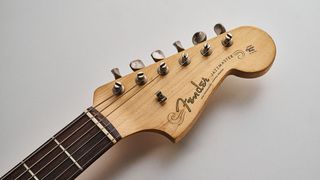
(Image credit: Future / Phil Barker)
The strings were anchored in a curved plate that passed through (but made no contact with) a baseplate that was screwed to the body. This string plate was placed over a strong spring at one end and pivoted against a knife edge at the other. The spring pressed up against the string plate to resist string-pull and the unit was fully floating.
The offset vibrato was designed for heavier gauge strings, but the lighter strings that were becoming commonplace revealed some issues with insufficient break angle
With a Strat vibrato, the springs stretch when the bar is depressed and then pull the bridge back into its default position. And with the offset vibrato, depressing the bar compresses the spring and equilibrium is restored when it expands.
This allowed Fender to implement a locking feature that would slide across to deactivate the vibrato and restore tuning in the event of string breakage. Some modern players have found this feature invaluable when drop tuning, but careful adjustments are needed for it to work.
The offset vibrato was designed for heavier gauge strings, but the lighter strings that were becoming commonplace revealed some issues with insufficient break angle, strings popping off saddles and extraneous noises behind the bridge.
Circuitry
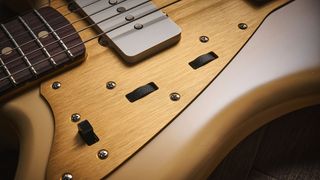
Fender Vintera II ’50s Jazzmaster (Image credit: Future / Phil Barker)
The Jazzmaster’s two fully independent circuits were inspired by a home-built lap steel that Forrest White showed Leo Fender in the early 1950s. This allowed players to switch instantaneously from a darker and quieter ‘rhythm’ tone to a louder and brighter ‘lead’ setting.
In rhythm mode, only the neck pickup is active, and the volume and tone settings are controlled by two knurled thumb-wheels. They barely protrude above the pickguard and do not obstruct the player.
A 50kohm tone potentiometer darkens the rhythm circuit because it’s much like a regular tone control that only operates between 3 and 0. The lead circuit is more conventional, with a three-way selector and master volume and tone controls. Rather than Fender’s usual 250k value, 1 meg-ohm potentiometers are used with a 0.033μF tone capacitor.
Jaguar wiring was very similar, but the rhythm circuit had a 0.01μF tone capacitor and Fender employed three slider switches on a metal plate, rather than a three-way switch. Two flicked the pickups on and off, while the third routed both pickup outputs through a 0.033μF capacitor that only allowed upper midrange and treble frequencies to pass through. It’s widely known as the ‘strangle’ switch.
The tone control is unconventionally wired, with a 56k resistor across the tone control’s input and wiper lugs, and the volume control connected from the wiper.
There is much debate about what this does, but the consensus is that it operates as a treble bleed that also shifts the cut-off frequency of the tone control upwards. With the strangle switch engaged, the resistor allows the tone control to operate more like a bandpass filter and it prevents drastic loss of volume when the tone control is rolled fully back.
Shielding
The Jazzmaster followed hot on the heels of Gretsch and Gibson’s humbucking pickups, but since Leo Fender remained a devotee of single-coil pickups, it became necessary to upgrade the shielding.
All of the Jazzmaster’s control and pickup cavities were lined with form-fitted brass shielding trays, and the earliest Jazzmasters had gold anodised pickguards. By early 1959, the control rout had been modified to accommodate the extra screws of a new celluloid nitrate pickguard, with a thin aluminium shield installed beneath.
For the Jaguar, Fender only installed flat brass plates in the bottom of the cavities. Metal coverplates were used for all three control cavities, but the shielding was far from complete.
Pickups
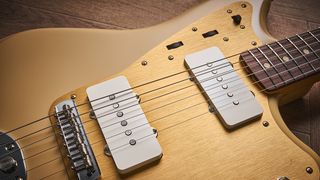
(Image credit: Future / Phil Barker)
To entice jazz players, Fender needed pickups that sounded fatter and warmer. One way to achieve that with a single-coil pickup is to make the coil wider and shallower. Stratocaster coils are around 7/16-inch tall, while Jazzmaster coils are only 1/8‑inch, and the coil widths are around 9/16-inch and 1 ½ inches respectively.
This also means that more magnet wire is needed to wind a Jazzmaster pickup with the same number of turns as a Strat pickup, so Jazzmaster DC resistance readings tend to read closer to 8k than 6k. But the higher inductance is more significant.
Of all the pre-CBS Fender pickups, Jazzmaster types varied more than any other
Typical Fender parts included vulcanised fiberboard flatwork and Alnico V magnetic slugs. The slugs were lightly bevelled at the top and barely protruded beyond the upper flat, but they extended further beyond the bottom flat.
Of all the pre-CBS Fender pickups, Jazzmaster types varied more than any other and offset expert Jim Shine has shared some invaluable information. From 1958 to 1962, the coils were scatter-wound with plain enamel wire that would fill the bobbin.
Fender used heavy Formvar magnet wire from 1962 until 1964, and began making the windings less scattered. Both types were potted in an alcohol activated material, which was probably blonde shellac.
During the CBS changeover period of 1964 to 1966, black flatwork changed to grey and Fender started dating the flatwork with stamps, pencil and black marker pen. Some coils during this era were wax-potted, but when Polysol magnet wire was introduced in 1965, Fender reverted to the alcohol-based potting liquid. Plastic insulated leadout wires replaced cloth wires in 1968 and, once again, date codes were stamped.
Leo Fender had concerns about the Jazzmaster’s ‘broad spectrum’ pickups placing excessive demands on valve amplifiers and causing distortion. In many ways, the Jaguar pickup was a return to type, with a narrower and taller coil that “put out a little more punch and a cleaner sound”, as Leo put it.
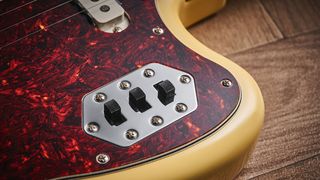
Fender Vintera II ’70s Jaguar (Image credit: Future / Phil Barker)
Although in essence a rehash of the Strat design, the Jaguar pickup had non-staggered Alnico V slugs and a solder terminal at each end of the lower flat. The obvious difference was a steel U-shaped yoke that enclosed the pickup.
In addition to raising inductance, it was supposed to lessen susceptibility to hum and modify the magnetic field – which it did to an extent, albeit with a small decrease in treble sensitivity.
Two of the ‘teeth’ are shorter than the others, so there’s fractionally less treble loss. The yoke can be fitted either way round, so place the shorter teeth adjacent to the strings you want to brighten up. Heavy Formvar 42 AWG magnet wire was only used in 1962, after which Fender changed to plain enamel wire of the same gauge. The slugs got a stagger in 1964.

Thank you for reading 5 articles this month**
Join now for unlimited access
US pricing $3.99 per month or $39.00 per year
UK pricing £2.99 per month or £29.00 per year
Europe pricing €3.49 per month or €34.00 per year
*Read 5 free articles per month without a subscription

Join now for unlimited access
Prices from £2.99/$3.99/€3.49
Huw started out in recording studios, working as a sound engineer and producer for David Bowie, Primal Scream, Ian Dury, Fad Gadget, My Bloody Valentine, Cardinal Black and many others. His book, Recording Guitar & Bass, was published in 2002 and a freelance career in journalism soon followed. He has written reviews, interviews, workshop and technical articles for Guitarist, Guitar Magazine, Guitar Player, Acoustic Magazine, Guitar Buyer and Music Tech. He has also contributed to several books, including The Tube Amp Book by Aspen Pittman. Huw builds and maintains guitars and amplifiers for clients, and specializes in vintage restoration. He provides consultancy services for equipment manufacturers and can, occasionally, be lured back into the studio.
>>> Read full article>>>
Copyright for syndicated content belongs to the linked Source : GuitarWorld – https://www.guitarworld.com/features/the-history-of-fender-offset-guitars







































